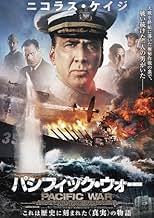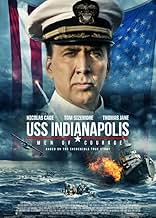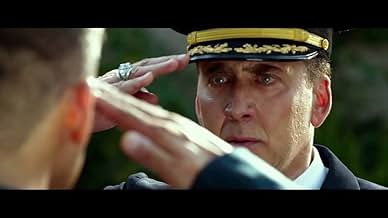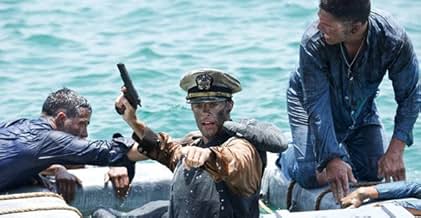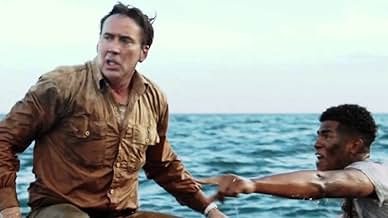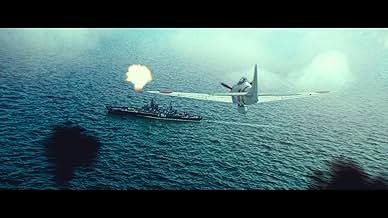VALUTAZIONE IMDb
5,3/10
15.098
LA TUA VALUTAZIONE
Durante la seconda guerra mondiale, una nave della marina americana viene affondata da un sottomarino giapponese lasciando 890 membri dell'equipaggio bloccati in acque infestate da squali.Durante la seconda guerra mondiale, una nave della marina americana viene affondata da un sottomarino giapponese lasciando 890 membri dell'equipaggio bloccati in acque infestate da squali.Durante la seconda guerra mondiale, una nave della marina americana viene affondata da un sottomarino giapponese lasciando 890 membri dell'equipaggio bloccati in acque infestate da squali.
- Regia
- Sceneggiatura
- Star
- Premi
- 1 candidatura in totale
Recensioni in evidenza
Men of Courage is not meant to be anything more than a generic mid- budget war movie with sharks, but it underdelivers even if you keep your expectations low. The script follows historical events pretty closely, but writing has lots of flaws, and romantic storyline is disappointing. Nicolas Cage gives a sensible performance, but his character doesn't move anywhere from "good captain" cliché. The writers add lots of voice-over narration to add depth to characters, which makes things worse. The Japanese captain is reduced to ridicule near the ending, where the two captains burst into tears while saluting each other.
If you only look for special effects, war scenes and sharks wreaking havoc, this movie won't be any less disappointing. Warship effects are of acceptable quality (for television at least), but man-eating sharks are either roughly made CGI, or replaced with smaller sharks which are obviously harmless. Not a single scene shows sharks biting humans; edits carefully avoid that part. No attention is given to the actual details of shark species present on the site of USS Indianapolis demise. For a movie that closely follows actual events (and even includes documentary footage), Men of Courage has an unacceptable number of inaccuracies. It's also badly edited, with scenes interrupted and tied together in strange places. Two hours last like four.
The story of USS Indianapolis appears more fascinating when you read the sources and memoirs, and it certainly deserves a better adaptation than one made by this movie's screenwriters.
If you only look for special effects, war scenes and sharks wreaking havoc, this movie won't be any less disappointing. Warship effects are of acceptable quality (for television at least), but man-eating sharks are either roughly made CGI, or replaced with smaller sharks which are obviously harmless. Not a single scene shows sharks biting humans; edits carefully avoid that part. No attention is given to the actual details of shark species present on the site of USS Indianapolis demise. For a movie that closely follows actual events (and even includes documentary footage), Men of Courage has an unacceptable number of inaccuracies. It's also badly edited, with scenes interrupted and tied together in strange places. Two hours last like four.
The story of USS Indianapolis appears more fascinating when you read the sources and memoirs, and it certainly deserves a better adaptation than one made by this movie's screenwriters.
Years ago I read "Abandon Ship" the story of the sinking of the USS Indianapolis by Richard F. Newcomb. It 's not the book the film is based on.
In some ways that's a pity. Although Newcomb's book was first published in 1960, it is a masterly account of the disaster and recounted events that are not in the film. I always remembered his description of the strong swimmers who rode herd on their weaker comrades pulling them back when they drifted away until they themselves used up their reserves of energy and drowned - many of the bravest acts of WW2 were not necessarily in the heat of battle.
Somewhere along the way, much of the drama leaked from this film.
It's unusual these days to see a movie where the special effects are not absolutely dazzling. They might be a cut above the old Hollywood bathtub effects, but the limitations of the effects in this film draw attention away from the story.
But that isn't the key weakness in "USS Indianapolis: Men of Courage".
Although Nicholas Cage gives a fine performance as Captain McVay, and the ending does have some punch, the filmmakers weren't content with what really happened, and added some very predicable fictional elements. Was it really necessary for Craig Tate and Johnny Wactor's characters to duplicate the scene from "Titanic" where Kate Winslet saves Leonardo DiCaprio from imprisonment in the nick of time? It's the forced backstories that rob the film of stature.
There was no need to expend so much energy on the fake elements. Here is a passage from Newcomb's book describing what happened when Lieutenant Gwinn, the pilot of the PV-1 Ventura who first spotted the men in the water was taken aboard the hospital ship "Tranquility" and introduced to the survivors as the guy who found them.
"Men in all stages of recovery, some weak and hollow-eyed on their beds shouted cheered and whispered. Those who could, crowded around and thumped him on the back, laughing and jumping. Some merely turned their heads on their pillows and cried softly, and the quiet, reticent Gwinn himself broke down under the flood of emotion".
I think I would have had that scene in my movie.
In some ways that's a pity. Although Newcomb's book was first published in 1960, it is a masterly account of the disaster and recounted events that are not in the film. I always remembered his description of the strong swimmers who rode herd on their weaker comrades pulling them back when they drifted away until they themselves used up their reserves of energy and drowned - many of the bravest acts of WW2 were not necessarily in the heat of battle.
Somewhere along the way, much of the drama leaked from this film.
It's unusual these days to see a movie where the special effects are not absolutely dazzling. They might be a cut above the old Hollywood bathtub effects, but the limitations of the effects in this film draw attention away from the story.
But that isn't the key weakness in "USS Indianapolis: Men of Courage".
Although Nicholas Cage gives a fine performance as Captain McVay, and the ending does have some punch, the filmmakers weren't content with what really happened, and added some very predicable fictional elements. Was it really necessary for Craig Tate and Johnny Wactor's characters to duplicate the scene from "Titanic" where Kate Winslet saves Leonardo DiCaprio from imprisonment in the nick of time? It's the forced backstories that rob the film of stature.
There was no need to expend so much energy on the fake elements. Here is a passage from Newcomb's book describing what happened when Lieutenant Gwinn, the pilot of the PV-1 Ventura who first spotted the men in the water was taken aboard the hospital ship "Tranquility" and introduced to the survivors as the guy who found them.
"Men in all stages of recovery, some weak and hollow-eyed on their beds shouted cheered and whispered. Those who could, crowded around and thumped him on the back, laughing and jumping. Some merely turned their heads on their pillows and cried softly, and the quiet, reticent Gwinn himself broke down under the flood of emotion".
I think I would have had that scene in my movie.
they should not allow filmmakers to use excellent true action packed war events unless they spend the money to get good writers and actors, then when it's all done, not allow it for release unless more than 80% veterans vote yes. thank you for trying but failing to use more talented peolpe to deliver movie. IMO the gov should sponsor these kind of stories with unlimited cash SPENDING.
Set in mid-1945 during World War II, the USS Indianapolis, led by Captain Charles McVay (Nicolas Cage), was secretly tasked to deliver parts of an atomic bomb (which would later be dropped on Hiroshima) unescorted to a naval base in the Pacific. Back in open sea after successfully delivering their cargo, the ship was torpedoed and sunk by a Japanese submarine in the Philippine Sea. The sailors spent five gruelling days with minimal supplies floating on life rafts in shark-infested waters. Only 317 of the original 1,196 crew members survive the ordeal.
The first hour of the film was quite brisk and eventful. The main storyline was laid out within the first scene. The backstory about some of the young sailors were introduced, oddly not too much on McVay himself. The USS Indianapolis embarked on its mission, torpedoed and sunk all within that first hour. However, this meant that the entire second hour would only be dealing about the survival ordeal of the sailors among the sharks awaiting rescue. It got maudlin and repetitive after the first few shark attacks. This was definitely not the war action film people were expecting to see.
The actors all seem to have come from the Nicolas Cage school of hammy acting. The major side story was about two friends who were in love with the same girl back home. Another side story was about a couple of sailors, one white, one black, constantly at odds with each other. There was also another side story about an arrogant young officer and his despicable attitude. All these rehashed side stories just served to fill out the rest of the running time before and after the sinking. The best actor for me would have to be Yutaka Takeuchi, the Japanese actor playing court-martial witness Commander Hashimoto, who displayed dignified subtly in his brief role.
For its Philippine release, this film's subtitle "Men of Courage" was replaced with "Disaster at (sic) Philippine Sea." However, for Filipino moviegoers expecting to actually see some part of the Philippines or see Filipinos in action in this film, they will be disappointed. The Philippines was mentioned but was never actually shown except for scene labels to establish the location. There was an extra card interrupting the closing credits stating how the search for the wreck of the Indianapolis was undertaken in 2001 in cooperation with the Philippine government and National Geographic. That was all about the Philippines here, nothing more. 5/10.
The first hour of the film was quite brisk and eventful. The main storyline was laid out within the first scene. The backstory about some of the young sailors were introduced, oddly not too much on McVay himself. The USS Indianapolis embarked on its mission, torpedoed and sunk all within that first hour. However, this meant that the entire second hour would only be dealing about the survival ordeal of the sailors among the sharks awaiting rescue. It got maudlin and repetitive after the first few shark attacks. This was definitely not the war action film people were expecting to see.
The actors all seem to have come from the Nicolas Cage school of hammy acting. The major side story was about two friends who were in love with the same girl back home. Another side story was about a couple of sailors, one white, one black, constantly at odds with each other. There was also another side story about an arrogant young officer and his despicable attitude. All these rehashed side stories just served to fill out the rest of the running time before and after the sinking. The best actor for me would have to be Yutaka Takeuchi, the Japanese actor playing court-martial witness Commander Hashimoto, who displayed dignified subtly in his brief role.
For its Philippine release, this film's subtitle "Men of Courage" was replaced with "Disaster at (sic) Philippine Sea." However, for Filipino moviegoers expecting to actually see some part of the Philippines or see Filipinos in action in this film, they will be disappointed. The Philippines was mentioned but was never actually shown except for scene labels to establish the location. There was an extra card interrupting the closing credits stating how the search for the wreck of the Indianapolis was undertaken in 2001 in cooperation with the Philippine government and National Geographic. That was all about the Philippines here, nothing more. 5/10.
The true story of the Indianapolis is a compelling one of bravery, intrigue, unimaginable suffering and governmental cowardice. This movie never comes close to conveying any of that. It rushes through the set-up, never pausing for us to get to know any of the principals in any depth. The movie can't wait to get to the sharks, but when it does, it almost turns into a comedy of unconvincing action, gaps in logic, ridiculous dialogue and clumsy CGI. Poor Nic Cage is reduced to a near catatonic state, forced into unnatural situations and dubious decisions. In Jaws, Spielberg did a better job in five minutes with Quint's recounting of his Indianapolis experience than this movie does in two hours. A fiasco. McHale's Navy was more realistic.
Lo sapevi?
- QuizMatt Lanter's grandfather was a survivor of the USS Indianapolis. In the film, Lanter wears his grandfather's dogtags.
- BlooperThe U.S. Navy was segregated until 1947. Black and white sailors would not have been allowed to sit together in the courtroom. They were also not allowed to fraternize.
- Citazioni
Captain McVay: There will always be war until we kill off our own species.
- Curiosità sui creditiDuring the credits, old photos from the USS Indianapolis and her crew roll alongside the credits.
- ConnessioniFeatured in Večernij Urgant: Renata Litvinova/Nicolas Cage (2016)
- Colonne sonoreA Jazzy Night
by Laurent Eyquem
I più visti
Accedi per valutare e creare un elenco di titoli salvati per ottenere consigli personalizzati
- How long is USS Indianapolis: Men of Courage?Powered by Alexa
Dettagli
- Data di uscita
- Paese di origine
- Sito ufficiale
- Lingue
- Celebre anche come
- Hombres de coraje
- Luoghi delle riprese
- USS Alabama, Mobile, Alabama, Stati Uniti(USS Indianapolis Exterior and Interior Set)
- Aziende produttrici
- Vedi altri crediti dell’azienda su IMDbPro
Botteghino
- Budget
- 40.000.000 USD (previsto)
- Lordo in tutto il mondo
- 2.158.568 USD
- Tempo di esecuzione
- 2h 8min(128 min)
- Colore
- Proporzioni
- 2.39 : 1
Contribuisci a questa pagina
Suggerisci una modifica o aggiungi i contenuti mancanti



